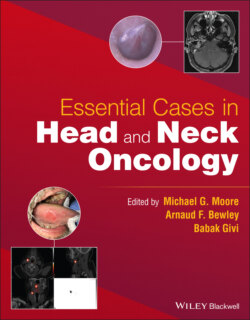Читать книгу Essential Cases in Head and Neck Oncology - Группа авторов - Страница 24
Management
ОглавлениеQuestion: What would you recommend next?
Biopsy of the lesion is the first step and is recommended even before imaging.
An office biopsy is performed and shows a moderately differentiated invasive SCC.
Question: What is the clinical stage at this point?
Answer: T2N1M0, stage III, based on a larger than 2 cm lesion and one palpable node. However, in alveolar lesions, it is important to evaluate the involvement of the bone, and these lesions could be upstaged to T4. Therefore, it is better to obtain imaging before assigning a clinical stage.
Question: What imaging modality would be an appropriate next step in the evaluation and management of this patient?
Answer: A CT of the neck and chest with IV contrast is an excellent next step as this will allow for evaluation of the extent of the primary lesion and to look for bone erosion as well as for any pathologic lymphadenopathy. CT of the chest helps to complete the staging. Alternatively, a PET/CT would be reasonable, but it may not allow for as good of resolution of the primary lesion to evaluate for bone involvement. Given that there is no evidence of neural deficits or concern for orbital or infratemporal fossa extension on physical exam, an MRI is probably not necessary (see Figures 3.1 and 3.2).
Chest CT demonstrated no evidence of metastatic disease.
Oromaxillofacial prosthodontics is consulted to assist with a dental impression and the production of an obturator if maxillectomy is considered.
Question: Based on your current assessment, what would be this patient's clinical stage?
Answer: This patient has oral cavity cancer. The primary lesion is staged based on size and depth of invasion. Here, depth is not known. Size puts it in the T2 category. Of note, minor bone erosion or maxillary involvement through a tooth socket alone does not upstage it to T4a. The patient has multiple ipsilateral pathologic nodes, none of which are larger than 6 cm in size, making him cN2b. Therefore, the stage is T2N2bM0: stage IVa.
Question: Given the above information, what would be the most appropriate management approach for this patient?
Answer: This patient has stage IVa oral cavity cancer. The optimal treatment strategy in patients who are amenable to surgery is for upfront surgical resection of the primary lesion with a concomitant neck dissection. Given the N2b neck dissection, he would benefit from adjuvant radiation therapy (RT ) or chemoradiation therapy, depending on the final margin status and the presence or absence of extracapsular spread.
Question: Figure 3.3 shows an intraoperative photo of the oral cavity defect after surgical resection of the primary tumor. What would you recommend for the reconstruction of the defects? What are the factors that should be considered in the reconstruction of the maxillary defect?
FIGURE 3.1 Axial (a) and coronal (b) cut of the primary lesion. Note there is minor bone erosion – no obvious extension into the pterygoid plates or muscles.
FIGURE 3.2 Axial cut of the neck portion of the CT demonstrating the pathologic node felt on physical examination. There was one additional node with evidence of central necrosis in right level 1b. Both lymph nodes were less than 3 cm in size.
FIGURE 3.3 Intraoperative photo of the right oral cavity defect after surgical resection of the primary tumor.
Answer: In a patient undergoing maxillectomy, it is critical to consider the best way to rehabilitate the defect. Limited defects, especially those with no communication to the sinonasal cavity, may require no reconstruction or simple adjacent tissue closure. For more extensive defects entering the sinonasal cavity, it is necessary to address this defect to allow for functional speech and swallowing. In this patient, an excellent option would be rehabilitation with a maxillofacial prosthesis. To do this, the patient must have adequate mouth opening and manual dexterity to allow for placement and removal. Moreover, retention is significantly improved when the ipsilateral canine tooth is maintained to allow for an adequate fulcrum for stability. Other contraindications to obturator use are resection of the orbital floor (unless a separate orbital floor repair is also performed) or resection of the anterior (premaxilla) or lateral (zygoma) projecting elements. Resection of the pterygoid plates does not significantly impact whether or not appropriate obturation can be achieved.
The patient's final pathology demonstrates a 3.2 cm primary tumor, resected closest margin is 4 mm, posteriorly. There was only minor bone erosion seen. The neck dissection specimen showed 5 out of 58 lymph nodes positive. The largest lymph node was 2.7 cm, and there was evidence of extracapsular spread.
Question: What would be the recommended next step in this patient's management?
Answer: This patient has pT2N3bM0, stage IVb disease based on the 8th Edition of the AJCC staging system. The presence of a close margin at the primary site would indicate the need to consider adjuvant radiation therapy. However, the presence of extracapsular spread of cervical lymph nodes (or the presence of a positive margin at the primary that cannot be re‐excised) is an indication for adjuvant chemoradiation therapy as this has been shown to improve overall survival and disease‐free survival. Since the posterior margin was close but clear, re‐excision would not be necessary. The patient will benefit from concurrent adjuvant chemoradiotherapy with platinum‐based agents.
